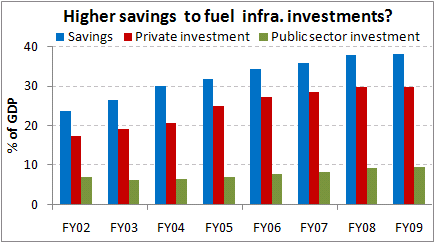India's infrastructure story goes well beyond roads, bridges and ports. It anchors on the savings of Indian citizens.
Yes, you read that right! As per the latest Goldman Sachs report, India will require US$ 1.7 trillion in financing over the next decade to meet its infrastructure needs. This estimate tops both Goldman Sachs' earlier estimate of US$ 620 bn as well as our government's 11th Five-Year Plan (2007-2012) infrastructure spending of US$ 500 bn. Even if the financing for the 11th Plan has been accounted for, we will need at least a trillion dollars more to execute the investments required.
Goldman Sachs expects most of the infrastructure investment to be funded by India's domestic savings without significant recourse to external borrowings. This belief stems from the trend of rising domestic savings rate and robust balance sheets of private sector companies. Goldman Sachs has pegged the gross savings rate in Asia's third largest economy to rise to 40% of GDP by 2016 (from 37% in FY09) and remain at high levels for well over a decade. These savings will be pertinent to fund public private partnership (PPP) projects that are estimated to fund 30% to 50% of the total infrastructure investment in the next decade.
However, what is even more important to note is that for this plan to fructify, India's household savings must be intermediated through the financial sector (pension funds, insurance and the like) to the government, which then spends on infrastructure. Else, as the chart shows, rising savings could possibly have little or no impact on public sector / infrastructure investments.
Source: CMIE
Allowing institutions like IIFCL to raise funds through long term bonds or allowing the Pension Fund Regulatory and Development Authority (PFRDA) to route investments from pension funds to equity and debt markets for the long term could be ideal ways to tap the potential savings.
Goldman Sachs expects most of the infrastructure investment to be funded by India's domestic savings without significant recourse to external borrowings. This belief stems from the trend of rising domestic savings rate and robust balance sheets of private sector companies. Goldman Sachs has pegged the gross savings rate in Asia's third largest economy to rise to 40% of GDP by 2016 (from 37% in FY09) and remain at high levels for well over a decade. These savings will be pertinent to fund public private partnership (PPP) projects that are estimated to fund 30% to 50% of the total infrastructure investment in the next decade.
However, what is even more important to note is that for this plan to fructify, India's household savings must be intermediated through the financial sector (pension funds, insurance and the like) to the government, which then spends on infrastructure. Else, as the chart shows, rising savings could possibly have little or no impact on public sector / infrastructure investments.
 |
Allowing institutions like IIFCL to raise funds through long term bonds or allowing the Pension Fund Regulatory and Development Authority (PFRDA) to route investments from pension funds to equity and debt markets for the long term could be ideal ways to tap the potential savings.
No comments:
Post a Comment